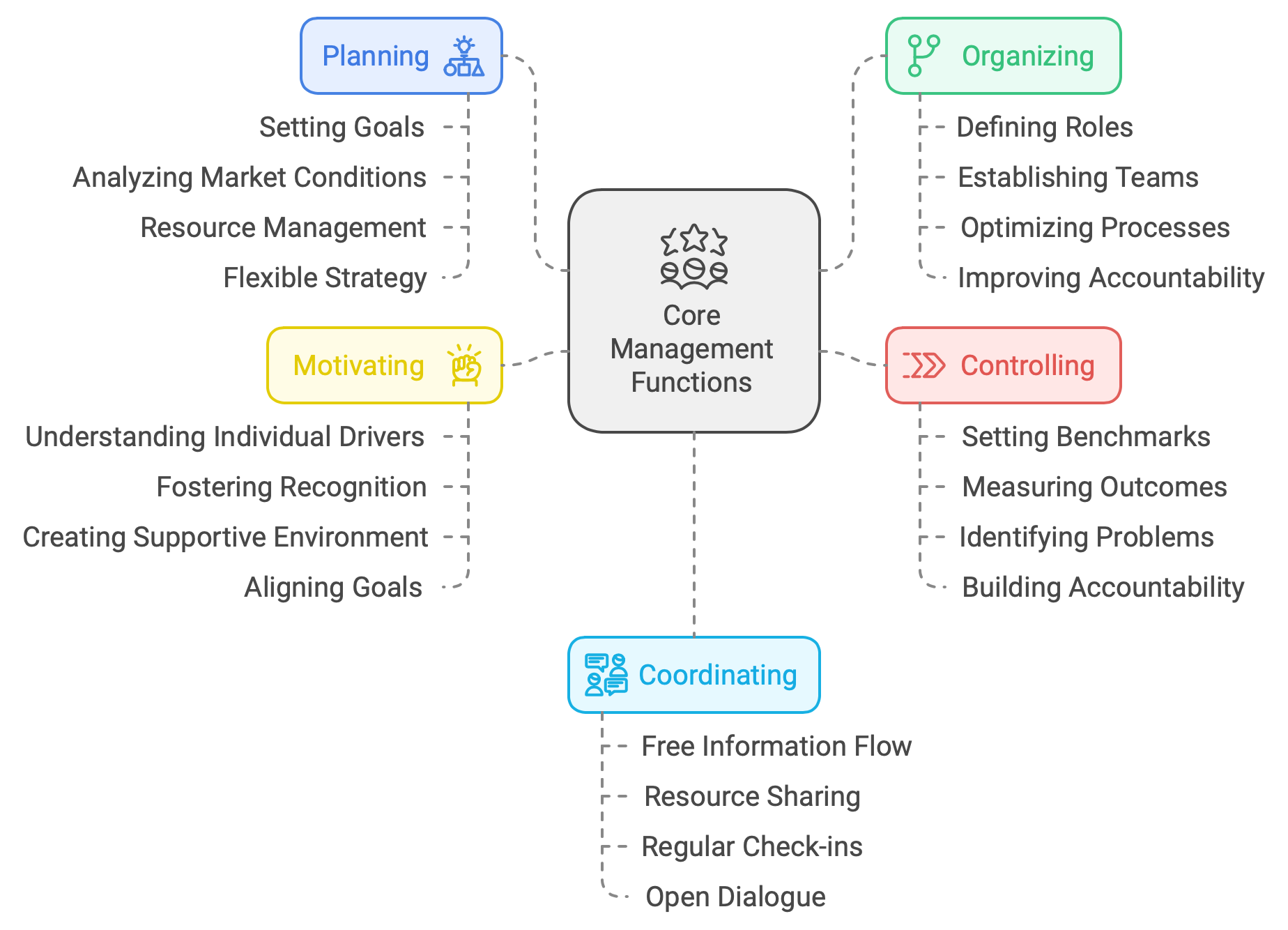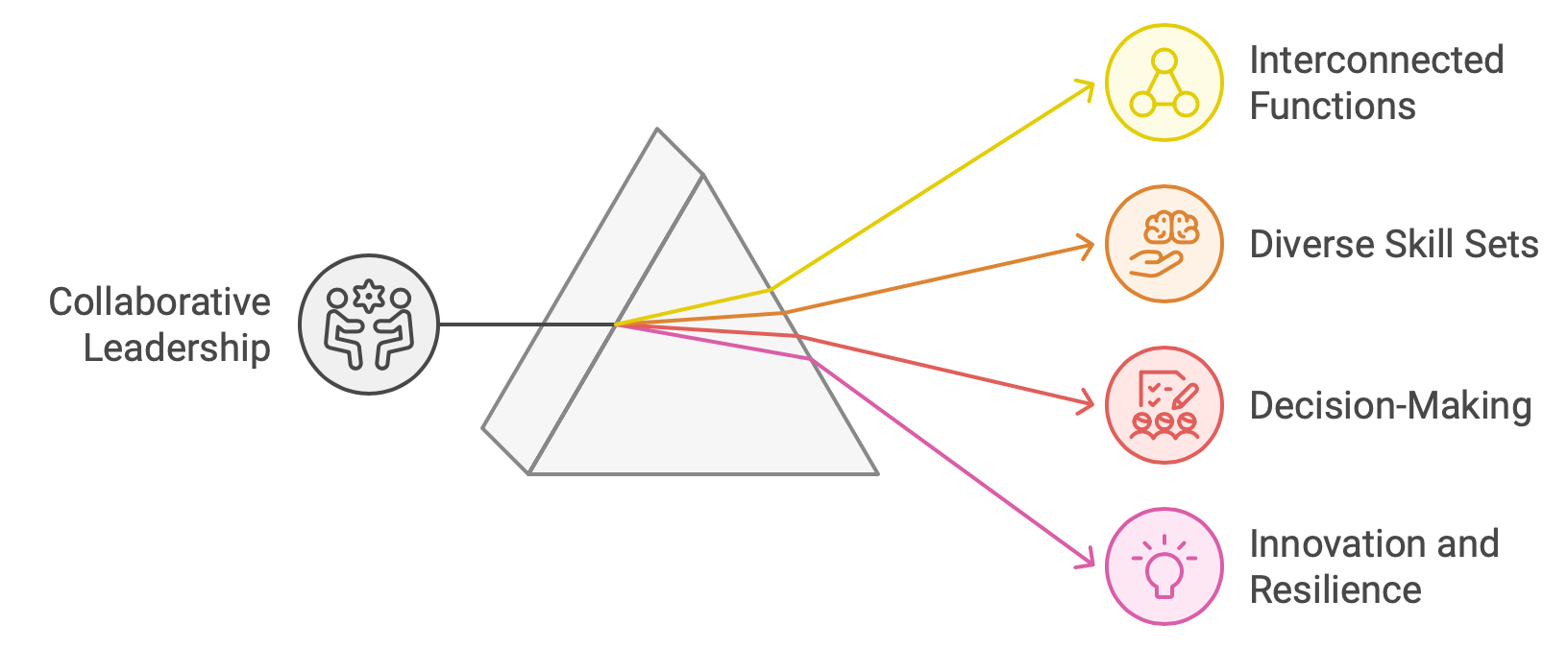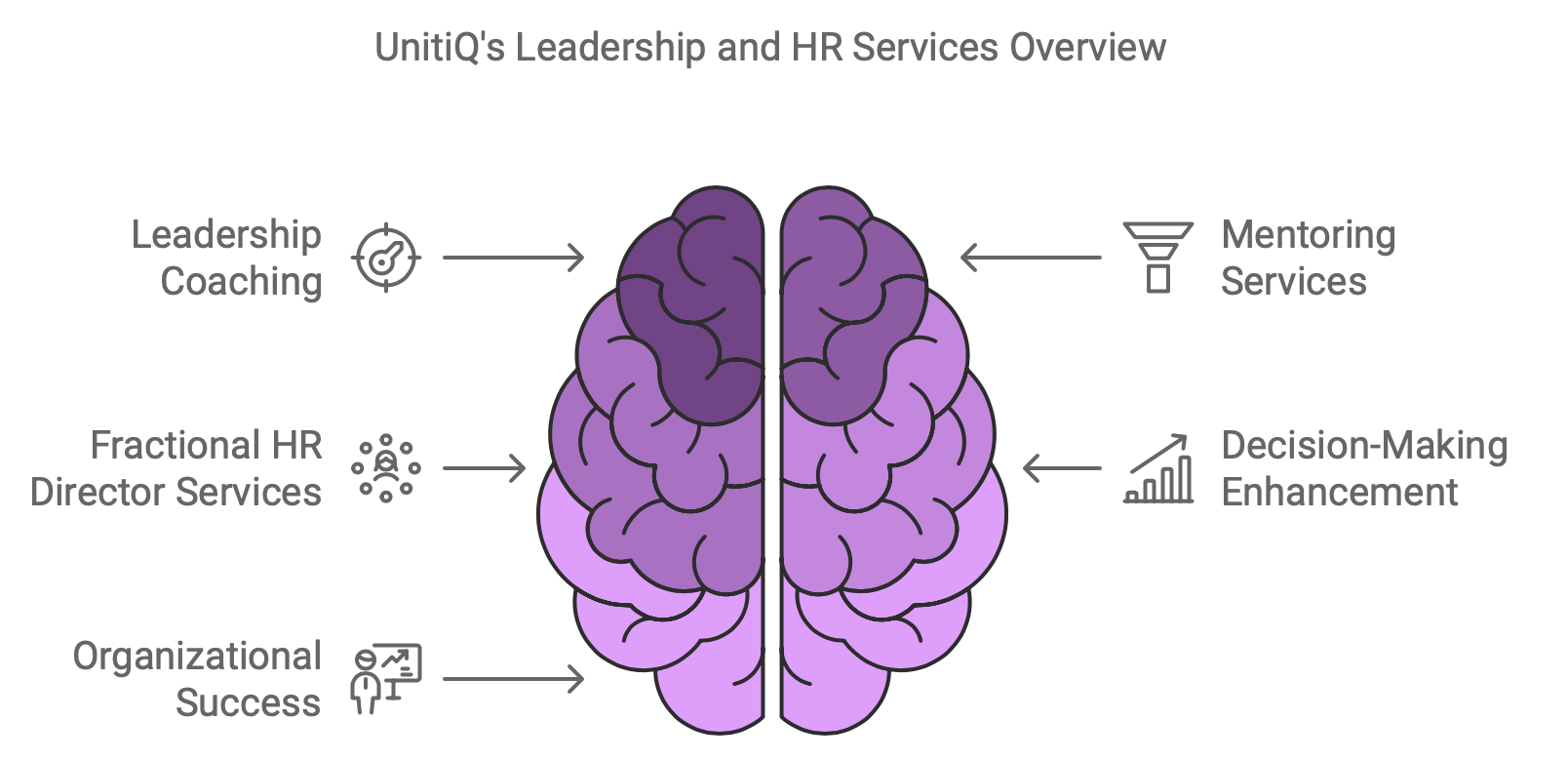Managing an organization has taught me that, regardless of how long you've been in the game, true success comes from mastering five essential management functions. These aren't just skills you pick up along the way—they are the strategic pillars that form the foundation of effective leadership. In my own journey, I’ve found that consistently applying these functions is what separates truly successful managers from those who face constant challenges. So let me share how these functions come to life in my experience, how they’ve shaped my leadership, and why they are absolutely critical to running any organization smoothly.

The Five Core Management Functions
When it comes to leading an organization, everything hinges on these five management functions: planning, organizing, controlling, motivating, and coordinating. Over time, I’ve come to see these functions not just as theoretical models but as practical, real-world tools that any successful manager must internalize. These five elements don’t operate in isolation—they work together to form a dynamic system. Understanding how they interact and influence one another is essential for driving an organization toward its goals and keeping it agile in the face of change.
Planning
Planning is where the whole process begins. It’s more than just setting goals—it’s about crafting a clear vision and developing a roadmap to achieve it. For me, planning is the cornerstone that allows me to guide the organization in the right direction. It’s a process that involves not only setting objectives but also analyzing market conditions, gathering data, and making informed decisions based on both past experiences and future projections.
Planning goes beyond predicting outcomes. It’s about building a strategy that’s flexible enough to adapt when the unexpected happens. I always ask myself: *What’s the most efficient use of our resources? How do we turn risks into opportunities?* By anchoring my plans in both current realities and future possibilities, I ensure that the organization can pivot and stay resilient when challenges arise.
For me, planning touches on every aspect of the business: managing resources like staff and budgets, designing business processes, planning for growth or innovation, and even laying out how communication should flow internally and externally. It's about seeing the big picture while also mapping out the detailed steps to get there. Empowering Busy Leaders to Share the Right Information at the Right Time
Planning goes beyond predicting outcomes. It’s about building a strategy that’s flexible enough to adapt when the unexpected happens. I always ask myself: *What’s the most efficient use of our resources? How do we turn risks into opportunities?* By anchoring my plans in both current realities and future possibilities, I ensure that the organization can pivot and stay resilient when challenges arise.
For me, planning touches on every aspect of the business: managing resources like staff and budgets, designing business processes, planning for growth or innovation, and even laying out how communication should flow internally and externally. It's about seeing the big picture while also mapping out the detailed steps to get there. Empowering Busy Leaders to Share the Right Information at the Right Time
Organization
After setting the plan, the next step is organizing—structuring the team and resources to bring that plan to life. Effective organization is the engine that drives execution. It’s not just about delegating tasks but about creating a system where every team member knows their role, understands their responsibilities, and has the resources they need to succeed.
In my experience, good organization is all about balance—making sure there’s no overlap in responsibilities, while also ensuring that no critical tasks fall through the cracks. The clearer the structure, the smoother the workflow. This involves everything from defining roles and setting up teams to establishing how different departments should collaborate. A well-organized team can adapt to challenges because every piece of the puzzle fits together seamlessly.
Organization is also about optimization—streamlining processes, improving accountability, and making sure that resources are allocated in a way that maximizes productivity. This ensures that every part of the organization is aligned and working together toward the same objective. Growth: Overcoming Micro-Management for a Thriving Work Environment
In my experience, good organization is all about balance—making sure there’s no overlap in responsibilities, while also ensuring that no critical tasks fall through the cracks. The clearer the structure, the smoother the workflow. This involves everything from defining roles and setting up teams to establishing how different departments should collaborate. A well-organized team can adapt to challenges because every piece of the puzzle fits together seamlessly.
Organization is also about optimization—streamlining processes, improving accountability, and making sure that resources are allocated in a way that maximizes productivity. This ensures that every part of the organization is aligned and working together toward the same objective. Growth: Overcoming Micro-Management for a Thriving Work Environment
Control
Control is what keeps everything on track. It’s the process of measuring and monitoring progress to ensure that the organization remains aligned with its goals. In my role, control isn’t about micromanaging but about creating systems that allow me to assess performance, measure outcomes, and make course corrections when necessary.
Control requires setting clear benchmarks and performance indicators so you can objectively evaluate how well the plan is being executed. In practice, this means keeping an eye on everything from financial performance and operational efficiency to team productivity. It also means being proactive—identifying potential problems before they escalate and addressing them head-on. For me, it's about building a culture of accountability where everyone understands the importance of staying aligned with the bigger goals.
Control requires setting clear benchmarks and performance indicators so you can objectively evaluate how well the plan is being executed. In practice, this means keeping an eye on everything from financial performance and operational efficiency to team productivity. It also means being proactive—identifying potential problems before they escalate and addressing them head-on. For me, it's about building a culture of accountability where everyone understands the importance of staying aligned with the bigger goals.
Motivation
Motivation is the key to unlocking the full potential of your team. Without a motivated workforce, even the best-laid plans can fall flat. Over the years, I’ve learned that motivation is about much more than just financial incentives—it’s about creating an environment where people feel inspired, valued, and empowered to contribute.
I focus on understanding what drives each person on my team, recognizing that everyone is motivated by different factors. Some may be driven by career advancement, others by the opportunity to innovate, and some by the desire to be part of a team that’s making a real difference. By tapping into these personal motivations, I’ve been able to align individual goals with the organization’s broader objectives. This not only boosts performance but also creates a stronger, more cohesive team.
I also believe that motivation is about fostering a culture of recognition and support. When people feel appreciated and know their efforts are making a difference, they’re far more likely to go the extra mile. It’s my job as a leader to create that environment.
I focus on understanding what drives each person on my team, recognizing that everyone is motivated by different factors. Some may be driven by career advancement, others by the opportunity to innovate, and some by the desire to be part of a team that’s making a real difference. By tapping into these personal motivations, I’ve been able to align individual goals with the organization’s broader objectives. This not only boosts performance but also creates a stronger, more cohesive team.
I also believe that motivation is about fostering a culture of recognition and support. When people feel appreciated and know their efforts are making a difference, they’re far more likely to go the extra mile. It’s my job as a leader to create that environment.
Coordination
Coordination is what ensures all the moving parts of the organization are working together effectively. It ties directly into the other functions, especially organizing, controlling, and planning. I see coordination as the glue that holds everything together. Without it, even the most detailed plans and well-organized teams can end up working in silos, leading to inefficiencies and missed opportunities.
In practice, coordination involves making sure that information flows freely between departments and that resources are shared where they’re needed most. It’s about ensuring that everyone is aligned and that there’s clear communication at all levels. I make it a point to hold regular check-ins and encourage open dialogue across teams to avoid miscommunication and ensure we’re all pulling in the same direction. Hierarchial structures prevent honest feedback from employees. How to overcome it?
In practice, coordination involves making sure that information flows freely between departments and that resources are shared where they’re needed most. It’s about ensuring that everyone is aligned and that there’s clear communication at all levels. I make it a point to hold regular check-ins and encourage open dialogue across teams to avoid miscommunication and ensure we’re all pulling in the same direction. Hierarchial structures prevent honest feedback from employees. How to overcome it?
Using These Functions Together
What I’ve found over the years is that these five functions—planning, organizing, controlling, motivating, and coordinating—are deeply interconnected. They support and strengthen each other, creating a management system that, when used correctly, can adapt to challenges, seize new opportunities, and drive consistent progress.
In today’s increasingly complex business environment, no single manager can master all of these functions alone. That’s why I often rely on cross-functional teams where leaders with diverse skill sets come together to tackle the multifaceted challenges of running an organization. Each person brings their strengths to the table, and together we form a leadership structure that can cover all the bases, from strategy to execution.
This collaborative approach not only improves decision-making but also fosters innovation and resilience within the organization. It’s about creating a leadership team that can see the big picture while also managing the details effectively.
In today’s increasingly complex business environment, no single manager can master all of these functions alone. That’s why I often rely on cross-functional teams where leaders with diverse skill sets come together to tackle the multifaceted challenges of running an organization. Each person brings their strengths to the table, and together we form a leadership structure that can cover all the bases, from strategy to execution.
This collaborative approach not only improves decision-making but also fosters innovation and resilience within the organization. It’s about creating a leadership team that can see the big picture while also managing the details effectively.
Final Thoughts

Looking back, I can say that mastering these five functions has been critical to my growth as a leader. Each function serves a purpose on its own, but when you integrate them into a cohesive system, they create a powerful framework for leading an organization. Whether it’s planning for the future, organizing the team, staying on top of progress, keeping people motivated, or ensuring smooth coordination, these functions provide the structure and flexibility needed to navigate the complexities of leadership.
What’s important is not just understanding these functions in theory but knowing how to adapt them to fit the needs of your specific organization. Leadership is an ever-evolving process, and the more I grow in my role, the more I realize that there’s always room to refine and improve how I apply these core functions. By staying open to learning and continuously developing my approach, I’ve been able to lead teams that are not only efficient but also innovative, resilient, and motivated to succeed.
In the end, effective management is about creating an environment where everyone can thrive, and these five functions provide the roadmap to making that happen. A good reason why startups fail
What’s important is not just understanding these functions in theory but knowing how to adapt them to fit the needs of your specific organization. Leadership is an ever-evolving process, and the more I grow in my role, the more I realize that there’s always room to refine and improve how I apply these core functions. By staying open to learning and continuously developing my approach, I’ve been able to lead teams that are not only efficient but also innovative, resilient, and motivated to succeed.
In the end, effective management is about creating an environment where everyone can thrive, and these five functions provide the roadmap to making that happen. A good reason why startups fail
Boost Leadership and HR Efficiency with UnitiQ’s Coaching and Fractional HR Director Service

UnitiQ offers comprehensive Leadership Coaching and Mentoring services designed to empower individuals and teams to reach their full potential. Whether you’re a new manager or an experienced executive, our tailored coaching helps you develop critical leadership skills, enhance decision-making, and drive organizational success. In addition to leadership coaching, UnitiQ also provides Fractional HR Director Services, offering expert HR support on a part-time basis. This flexible service can include leadership coaching as needed, ensuring that your organization not only has top-tier HR guidance but also the tools to cultivate strong, effective leaders who can guide your team through growth and change.
Contact me directly:
My Telegram and LinkedIn Profiles.
Contact me directly:
My Telegram and LinkedIn Profiles.
